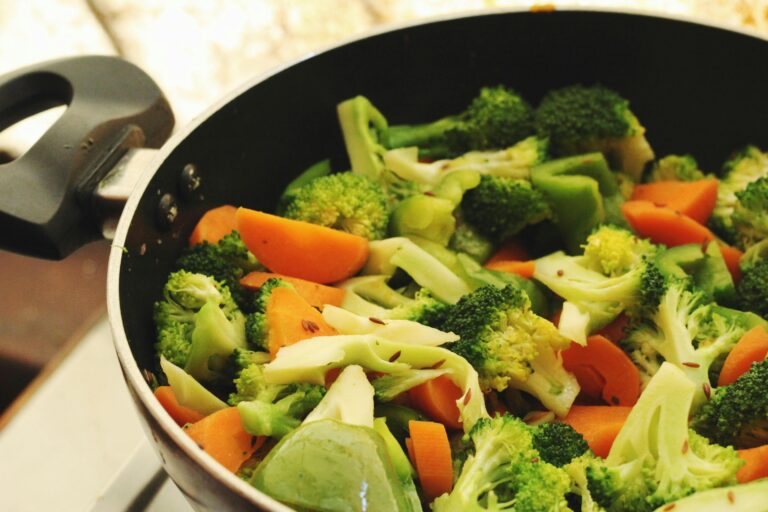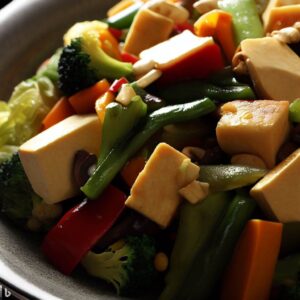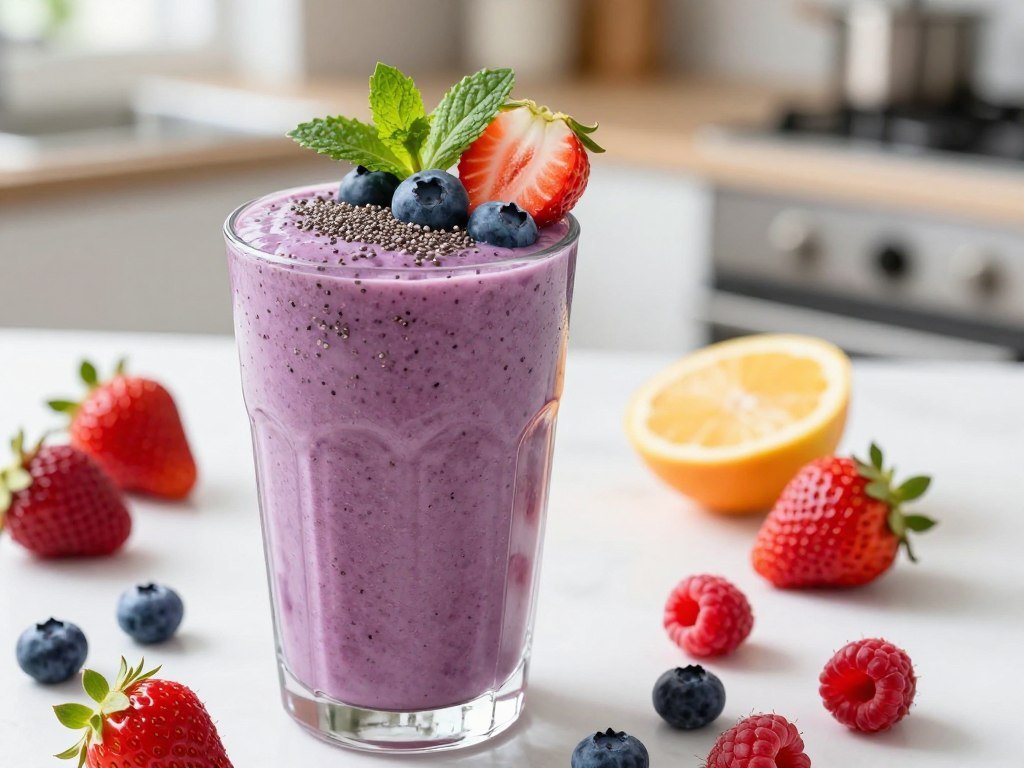As an Amazon Associate I earn from qualifying purchases.
Easiest Vegetable Stir-Fry
Vegetable Stir-Fry Recipe
Nutrient Information (Approximate values per serving):
- Calories: Around 150-200 kcal (excluding rice/noodles and added protein)
- Protein: Approximately 5-10g (varies based on added protein)
- Fat: Approximately 7-10g
- Carbohydrates: About 15-20g
- Fiber: Roughly 4-6g
- Sugar: Around 4-6g (naturally occurring sugars from vegetables)
- Vitamins: Rich in various vitamins, including vitamins A and C from vegetables.
- Calcium: Approximately 50mg (from vegetables)
- Iron: Roughly 1.5mg (from vegetables)
Prep Time: 15-20 minutes
Serving Size: 1 serving (without rice/noodles and added protein)

Ingredients:
- Assorted vegetables (e.g., broccoli, carrots, snow peas, mushrooms, bell peppers, etc.), chopped
- 2 cloves garlic, minced
- 1 teaspoon ginger, minced
- 2 tablespoons soy sauce (low-sodium recommended)
- 1 tablespoon cooking oil (such as vegetable oil or sesame oil)
- Optional: sliced tofu, tempeh, or cooked chicken for added protein
- Cooked rice or noodles for serving
Instructions:
Prepare Ingredients: Wash, peel, and chop the vegetables into bite-sized pieces. Mince the garlic and ginger.
Stir-Fry: In a wok or a large skillet, heat the cooking oil over medium-high heat. Add the minced garlic and ginger, and sauté for about 30 seconds until fragrant.
Add Vegetables: Add the chopped vegetables to the wok. Stir-fry for 3-5 minutes until they start to become tender. If you’re using protein (tofu, tempeh, or chicken), add it at this stage and cook until it’s heated through.
Soy Sauce: Pour the soy sauce over the vegetables and toss everything to combine. Continue to cook for an additional 2-3 minutes until the vegetables are cooked to your desired level of doneness. The sauce will help flavor the vegetables.
Serve: Serve the stir-fried vegetables over cooked rice or noodles. You can garnish with additional chopped herbs, sesame seeds, or sliced green onions if desired.
Please note that these values are approximations and can vary based on the specific types and quantities of vegetables used, as well as the choice of added protein and oil. The nutrient information also doesn’t account for variations in soy sauce, garlic, ginger, and other seasonings used, so the actual values might vary slightly. It’s always a good idea to double-check with a nutritional calculator or tool if you need precise values.
Enjoy your nutritious and delicious Vegetable Stir-Fry!
Brown rice is a nutritional powerhouse that offers numerous health benefits. Unlike white rice, it retains its bran and germ layers and is rich in fiber, vitamins, and minerals. This makes it an excellent choice for promoting digestive health, regulating blood sugar levels, and reducing the risk of chronic diseases like type 2 diabetes. Additionally, brown rice is an excellent source of complex carbohydrates, providing sustained energy throughout the day. Its high manganese content supports bone health, while antioxidants like selenium protect cells from oxidative damage. Incorporating brown rice into your diet is a delicious way to enhance overall well-being and nutrition.
Replace your "meat" with:
Tofu and Tempeh
In the world of plant-based eating, tofu and tempeh often take center stage as versatile and protein-rich ingredients. These soy-based wonders have been enjoyed for centuries in various cuisines and have become staples in the diets of many vegetarians and vegans.
The are a variety of recipes that you can dive into what tofu and tempeh are and explore their incredible versatility in plant-based cooking.
Tofu and tempeh are culinary treasures for anyone exploring plant-based eating. Their versatility, nutrient content, and ability to absorb flavors make them essential vegan or vegetarian kitchen ingredients. Whether you’re a seasoned plant-based eater or just starting your journey, these soy-based wonders will inspire your creativity in the kitchen and contribute to a healthier, more sustainable lifestyle. Recipes
Plant-Based Vegetables
Plant-Based Vegetables to Elevate Your Tofu Vegetable Stir-Fry
Tofu vegetable stir-fry is a delightful and nutritious dish that can be tailored to suit various tastes. Whether you’re a dedicated vegetarian or want to incorporate more plant-based meals into your diet, this dish is a fantastic choice. To elevate your stir-fry game, consider adding these plant-based vegetables to create a colorful and flavorful medley:
- Broccoli: Broccoli not only adds a vibrant green hue but also provides a generous dose of fiber, vitamins, and minerals. It offers a delightful crunch and pairs well with the softness of tofu.
- Bell Peppers: The trio of red, yellow, and green bell peppers not only adds a burst of color but also contributes a sweet, tangy flavor to your stir-fry. They’re rich in vitamin C and antioxidants.
- Snap Peas: Snap peas offer a refreshing crispness and a slightly sweet taste. They are a good source of fiber, making your stir-fry more satisfying.
- Bok Choy: This leafy green veggie has a mild, slightly peppery flavor and a pleasant crunch. It’s rich in vitamins A and C, as well as calcium.
- Mushrooms: Whether you choose shiitake, cremini, or button mushrooms, they impart a savory, umami flavor to your stir-fry. They’re also a great source of essential nutrients like selenium and B vitamins.
- Baby Corn: These mini cobs not only add visual appeal but also a subtle sweetness. They’re low in calories and contain essential minerals like potassium and magnesium.
- Water chestnuts: They bring a satisfying crunch to the dish, along with their mild, slightly sweet taste. They’re low in calories and a good source of potassium.
When preparing your tofu vegetable stir-fry, remember to season with soy sauce, ginger, garlic, and other preferred seasonings. Combining tofu and these plant-based vegetables will create a satisfying and nutritious meal that’s sure to please your taste buds. Experiment with different combinations to discover your favorite variation of this delicious and wholesome dish.


Easiest Vegetable Stir-Fry
EatMoveHealthyEquipment
- 1 Wok or large skillet
- 1 Cutting Board
- 1 Sharp knife
- 1 Mixing spoon or spatula (heatproof)
- Measuring spoons
- Serving bowls/plates
Ingredients
- Assorted vegetables: Broccoli, carrots, snow peas, mushrooms, bell peppers, Chopped Bell Peppers, Sliced Mushroom,
- 2 cloves Garlic minced
- 1 teaspoon Ginger minced
- 2 tablespoons Soy Sauce low-sodium recommended
- 1 tablespoon Cooking Oil (Sesame Oil) such as vegetable oil or Optional: sliced tofu, tempeh, or cooked chicken for added protein
- Cooked rice or noodles for serving
Instructions
- Prepare Ingredients: Wash, peel, and chop the vegetables into bite-sized pieces. Mince the garlic and ginger.
- Stir-Fry: In a wok or a large skillet, heat the cooking oil over medium-high heat. Add the minced garlic and ginger, and sauté for about 30 seconds until fragrant.
- Add Vegetables: Add the chopped vegetables to the wok. Stir-fry for 3-5 minutes until they start to become tender. If you're using protein (tofu, tempeh, or chicken), add it at this stage and cook until it's heated through.
- Soy Sauce: Pour the soy sauce over the vegetables and toss everything to combine. Continue to cook for an additional 2-3 minutes until the vegetables are cooked to your desired level of doneness. The sauce will help flavor the vegetables.
- Serve: Serve the stir-fried vegetables over cooked rice or noodles. You can garnish with additional chopped herbs, sesame seeds, or sliced green onions if desired.
Notes
Protein: Approximately 5-10g (varies based on added protein)
Fat: Approximately 7-10g
Carbohydrates: About 15-20g
Fiber: Roughly 4-6g
Sugar: Around 4-6g (naturally occurring sugars from vegetables)
Vitamins: Rich in various vitamins, including vitamins A and C from vegetables.
Calcium: Approximately 50mg (from vegetables)
Iron: Roughly 1.5mg (from vegetables) The cost per serving for the Easiest Vegetable Stir-Fry is approximately $2.00–$2.50 (without rice/noodles or added protein). 👉 If you include tofu, tempeh, or chicken, the cost may increase to around $3.00–$4.00 per serving depending on the protein choice.
Nutrition
FAQs:
- High Heat: Stir-frying is typically done over high heat to cook ingredients while preserving their texture and flavor quickly.
- Cut Uniformly: Cut ingredients into uniform sizes to ensure even cooking.
- Constant Stirring: Keep the ingredients moving in the pan to prevent sticking and ensure even cooking.
- High Heat: Stir-frying is typically done over high heat to cook ingredients while preserving their texture and flavor quickly.
- Cut Uniformly: Cut ingredients into uniform sizes to ensure even cooking.
- Constant Stirring: Keep the ingredients moving in the pan to prevent sticking and ensure even cooking.
- High Heat: Stir-frying is typically done over high heat to cook ingredients while preserving their texture and flavor quickly.
- Cut Uniformly: Cut ingredients into uniform sizes to ensure even cooking.
- Constant Stirring: Keep the ingredients moving in the pan to prevent sticking and ensure even cooking.
- The secret to successful vegetable stir-frying is a perfect balance between a seared exterior and a crisp-tender interior. Quick cooking and high heat help retain the vibrant colors and nutrients of the vegetables while giving them a delightful crunch.
- When stir-frying, start with the vegetables that take the longest to cook. Typically, this means cooking denser vegetables like carrots or broccoli before adding softer ones like bell peppers or snap peas. This ensures that all the veggies reach the desired doneness together.
- Traditionally, stir-frying is done with oil, which has a higher smoke point than butter. Oil, such as vegetable or sesame oil, is the preferred choice for stir-frying because it can withstand high temperatures without burning. Butter is not typically used due to its lower smoke point.
- To make a healthier plant-based stir-fry, you can replace oil with alternatives like vegetable broth, water, or low-sodium soy sauce for a “water sauté.” This reduces the added fat in the dish while still achieving the desired texture and flavor. Another option is using a small amount of oil or oil spray and focusing on a non-stick pan to reduce the overall fat content while achieving classic stir-fry results.
Amazon and the Amazon logo are trademarks of Amazon.com, Inc or it's affiliates.
Related Posts
- Best Gift Ideas for Every Occasion
Best Gift Ideas for Every Occasion Finding the perfect gift can be challenging, whether for…
- Positivity Its Impact on Health
Positivity and Its Impact on Health Positivity: The Path to a Healthy Lifestyle and Overcoming…
- What is the Best Diet For You
What is the Best Diet for You Plant-Based or Fasting A Complete Analysis of Plant-Based…









